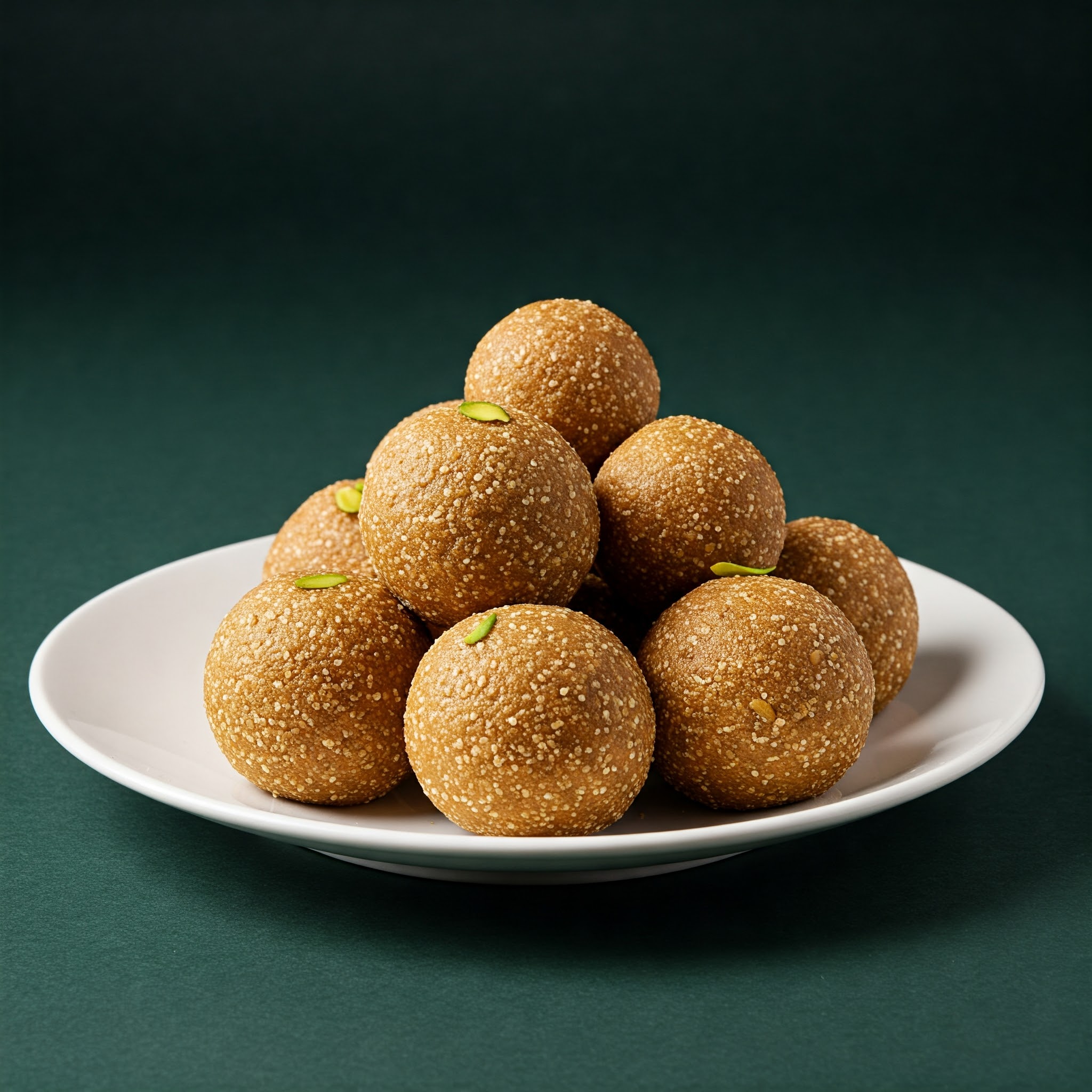Tapioca Flour (साबूदाने का आटा)
Sabudana ka atta

About Tapioca Flour
Embrace the Versatility of Tapioca Flour
In the heart of Indian kitchens, where flavors dance and aromas weave a story of tradition, tapioca flour holds a special place of its own. Known for its delicate texture and neutral flavor, tapioca flour is the key ingredient that binds together a variety of dishes, from the crispy delights of sabudana vada to the silky richness of sabudana khichdi. It transforms every meal into a sensory experience—light, fluffy, and delightfully satisfying.
Often revered for its ease of digestion, tapioca flour is a gluten-free marvel that offers a safe haven for those seeking to avoid gluten. It's not just about taste—tapioca flour provides essential energy in the form of carbohydrates, while also being low in fat, making it a healthy choice for the whole family. Rich in iron, it contributes to boosting immunity, and its high fiber content aids in maintaining a healthy digestive system.
To include tapioca flour in your daily menu, logon to planmeal.com, your trusted automatic meal planner, and discover recipes that will bring a new twist to your meals!
Imagine sinking your teeth into warm, soft sabudana khichdi—the perfect balance of lightness and flavor, or indulging in a spoonful of sabudana kheer, a sweet pudding that melts in your mouth. The versatility of tapioca flour makes it a wonderful ingredient for both savory and sweet dishes.
Healthy, Tasty, and So Easy!
The Significance of Tapioca Flour
Tapioca flour is an essential staple in many kitchens, offering both versatility and a host of health benefits. Made from the root of the cassava plant, it is widely used in cooking and baking due to its unique properties.
Why Tapioca Flour is Important:
- Natural Thickener: Tapioca flour acts as a natural thickening agent for soups, sauces, and puddings. Its smooth texture helps create consistency in dishes without altering their flavors.
- Gluten-Free Substitute: With an increasing demand for gluten-free diets, tapioca flour has emerged as a top substitute for traditional wheat flour in gluten-free recipes. It provides the same binding properties and consistency needed in baking.
- Supports Digestion: Tapioca flour is easy on the stomach and can be especially beneficial for individuals with digestive issues. It promotes better digestion due to its low fiber content, making it gentle on sensitive stomachs.
- Energy Boosting: Rich in carbohydrates, tapioca flour serves as a quick source of energy, making it a great option for active individuals or those in need of an energy boost during the day.
Health and Culinary Benefits Combined: Beyond its nutritional advantages, tapioca flour’s light, neutral taste makes it ideal for creating a wide array of dishes, from savory snacks to sweet desserts. Whether you are making a crispy snack or a creamy dessert, tapioca flour adds a delightful texture to every dish.
In Conclusion: Tapioca flour is not just a cooking ingredient, but a health-conscious choice that can enhance the texture, flavor, and nutritional profile of your meals. It is a versatile, gluten-free option that benefits a wide range of dietary needs.
How to Store Tapioca Flour
How to Store Tapioca Flour
Proper storage is crucial to maintain the freshness and quality of tapioca flour. Follow these tips for optimal storage:
- Cool, Dry Place: Store tapioca flour in a cool, dry place, away from direct sunlight, heat, or humidity. A pantry or cupboard is ideal.
- Airtight Container: Transfer the flour to an airtight container once opened. This helps prevent moisture and air from affecting its texture and quality.
- Seal the Package: If you don’t have an airtight container, make sure the original package is tightly sealed.
- Refrigeration/Freezing: For extended shelf life, consider storing tapioca flour in the refrigerator or freezer, especially if you live in a hot and humid environment. Just make sure it's in a well-sealed container to avoid moisture.
Avoid Selecting or Procuring Tapioca Flour
- Check Expiry Date: Always check the expiry or best-by date before purchasing tapioca flour. Avoid buying products that are close to expiration.
- Inspect Packaging: Avoid purchasing tapioca flour if the packaging is damaged, opened, or compromised, as this can lead to contamination and spoilage.
- Avoid Bulk Purchases: Only buy what you need, as buying in large quantities can lead to the flour being stored for too long, increasing the risk of spoilage.
- Quality Check: If the flour seems off, has an unusual odor, or appears clumpy, avoid selecting it.
Storage Summary:
- Store in a cool, dry place, away from heat and humidity.
- Keep in an airtight container to protect from air and moisture.
- For longer shelf life, refrigerate or freeze.
Shelf Life of Tapioca Flour
Shelf Life of Tapioca Flour
Tapioca flour is a shelf-stable product, but its shelf life can vary depending on how it is stored. Typically, tapioca flour can last:
- Unopened package: Up to 1-2 years when stored in a cool, dry place, away from direct sunlight.
- Opened package: Up to 6 months if kept in an airtight container in a cool, dry place.
Storage Tips:
- Keep the flour in an airtight container to prevent moisture and air exposure.
- For longer storage, you can refrigerate or freeze tapioca flour, which can extend its shelf life to 1-2 years.
Signs of Spoilage:
- Off smell: A sour or rancid odor indicates it is no longer good.
- Color changes: If the flour turns a darker shade or develops any discoloration, it may be spoiled.
- Presence of bugs or pests: If you notice any insects or foreign particles, discard the flour.
In conclusion, tapioca flour can be kept for a long time if stored properly, but always check for signs of spoilage before use.
How to Check Tapioca Flour Before Buying
How to Check Tapioca Flour Before Buying
When purchasing tapioca flour from a local vendor, it's important to ensure its quality and freshness. Here are a few simple checks:
- Check the Packaging: Ensure that the packaging is intact and tightly sealed. Avoid buying if the package is damaged, opened, or if there are signs of contamination.
- Examine the Flour: Tapioca flour should be white or off-white in color. If it appears yellowish or has any discoloration, it may indicate poor quality or spoilage.
- Smell Test: Fresh tapioca flour has a neutral, mild smell. If it has a sour, rancid, or musty odor, it’s best to avoid purchasing it.
- Texture: The flour should feel fine and powdery. If it feels clumpy or has an unusual texture, it could be a sign of moisture absorption or poor storage.
When to Buy Tapioca Flour in Bulk
It’s ideal to buy tapioca flour in bulk during the dry months, usually between October to March, when humidity levels are lower. Bulk purchases during this period reduce the risk of spoilage from moisture. Ensure that you store the flour in an airtight container in a cool, dry place to maintain its freshness for a longer period.
Explore
Explore our services and take your business to the next level.
Recent Posts

Kuttu Ladoo is the perfect addition to your weekly meal plan, offering a delicio...

Spiced Buttermilk is the perfect addition to your weekly menu, offering a refres...

Kuttu Ki Poori is a delicious and wholesome addition to your weekly meal plan. M...

Bajra Khichdi is a wholesome, nutrient-packed meal perfect for your weekly menu....

Curd Sandwich is a fantastic addition to your balanced weekly menu, offering a h...
Ready for a Healthier You?
Take control of your wellness! Get a customized meal plan that fits your lifestyle. It's time to eat smarter, feel better, and transform your life!
Get Your Plan Now!Already a member? Login and start now!
Nutrition Facts
Serving Size:
Servings Per Container: 1
| Amount Per Serving | ||
|---|---|---|
| Calories | 360 | |
| Fat | ||
| Saturated Fat | ||
| Trans Fat | ||
| Cholesterol | 0 | |
| Sodium | 1 | |
| Carbs | 86.0 | |
| Fiber | ||
| Sugar | 0 | |
| Protein | 0 | |
| VitaminD | ||
| Calcium | 20 | |
| Iron | 0 | |
| Potassium | 20 | |
* Percent Daily Values are based on a 2000 calorie diet.
* Percent Daily Values are based on a 2000 calorie diet.

